后置定语的用法
什么是英语的后置定语的讲解

什么是英语的后置定语的讲解后置定语是英语和汉语中不可或缺的重要语法内容之一,而英语后置定语在构成上比汉语后置定语要更加多样化,下面是店铺整理的什么是英语的后置定语,欢迎阅读。
什么是英语的后置定语定语的位置一般有两种:用在所修饰词之前的叫前置定语,用在所修饰词之后的叫后置定语。
例:This is a very interesting book. 这是一本很有趣的书。
一般情况下,修饰名词或代词的词多放在被修饰词之前,但在以下几种情况下,修饰名词或代词的定语却放在它们之后,这种定语我们称之为后置定语。
英语后置定语的讲解一、形容词作疑问词的后置定语修饰疑问词what, which, who, whose, whom, when, where, why, how时,修饰语要后置。
例如:1)What important would you like to talk about?你将谈论什么重量的事情?2)Who else will go with us?还有谁将和我们一起去?3)Where new have they decided to visit?他们决定到哪些没有去过的地方参观?二、形容词作复合不定代词的后置定语当被修饰词为复合不定代词something, anything, nothing, everything; somebody, anybody, nobody, everybody; someone, anyone, everyone, no one时,修饰语常位于被修饰的不定代词之后。
例如:1)I have something important to tell you.我有些重要的事情要告诉你。
2)Do you have anything else to say about it?关于这件事,你还有什么要说的吗?3)Someone important will give the students a lecture on thecurrent international situation this afternoon.今天下午,一位重要的人物将给学生们做一场有关当前国际形势的报告。
初中后置定语知识点总结

初中后置定语知识点总结在学习英语的过程中,定语是一个非常重要的语法项目。
在句子中,定语通常是用来修饰名词或代词,限定或说明它们的。
在英语中,定语通常放在被修饰的名词或代词之前,这被称为前置定语。
但是也有一些情况,定语出现在被修饰的名词或代词之后,这被称为后置定语。
今天我们就来总结一些初中后置定语的知识点。
一、后置定语的基本概念后置定语是指放在被修饰名词或代词之后的定语。
后置定语可以是限制性定语,也可以是非限制性定语。
限制性定语是不可省略的,非限制性定语是可以省略的。
1. 限制性定语:这种定语对被修饰的名词或代词起限制性作用,是不可缺少的。
例如:The man sitting over there is a teacher.那个坐在那儿的人是一名老师。
2. 非限制性定语:这种定语对被修饰的名词或代词起补充说明的作用,可以省略。
例如:My father, born in 1960, is a doctor.我的父亲,生于1960年,是一名医生。
二、后置定语的形式后置定语的形式多种多样,可以是一个单词,也可以是一个短语,还可以是一个从句。
在后置定语中,我们常见的形式有形容词、过去分词、现在分词、不定式、介词短语、副词短语和定语从句等。
下面我们逐一来看一下。
1. 形容词:由形容词构成的后置定语通常放在被修饰的名词或代词之后,起限制性或非限制性作用。
例如:The girl wearing a red dress is my sister.(限制性)穿着红色礼服的女孩是我的妹妹。
My friend, rich and generous, often helps others.(非限制性)我的朋友,富有和慷慨,经常帮助别人。
2. 过去分词:由过去分词构成的后置定语通常放在被修饰的名词或代词之后,表示被动或完成。
例如:The book translated into Chinese is very popular.(被动)被翻译成中文的书非常受欢迎。
英语后置定语的详细用法

单个词做后置定语
02
Байду номын сангаас
(一)形容词做后置定语
2.英语中有些以a为词首的形容词做定语时,均放在被修饰语后面。如:alone, alike, afraid, , ashamed, awake 等 The girl asleep is my younger sister. He is the greatest writer alive.
我的句子:那个被Tom打的男孩是杨清。(beat)
named
written
3.动词不定式做后置定语: 与被修饰成分之间表示不同的语义关系: (1)表示动宾关系(2)表示主谓关系 (3)表示修饰关系 (4)表示同位关系
(1)表示动宾关系 被修饰的名词为动词不定式to do的直接宾语。 I have a lot of work to do today. He had a big family to support. I don’t have a house to live in . I don’t have a pen to write with. I don’t have a piece of paper to write on
He looked at the street full of cars(形容词短语)
我的句子:
副词做后置定语时一般表示时间、地点等. The weather here is very nice. The building around are modern .
(二)副词做后置定语
Is there anybody wounded? There is no money left . 我的句子:这儿的食物很美味。(副词) 我没有剩余的钱了。(过去分词)
初中动词不定式后置定语的六种用法总结

初中动词不定式后置定语的六种用法总结好啦,今天咱们来聊聊“动词不定式后置定语”这种神奇的语法结构,嘿,这听起来是不是有点高大上?其实呢,这个结构一点也不复杂。
只是用动词不定式做定语,这样的形式不但能让咱们的语言更加生动有趣,还能让你在英语学习中更具魅力。
你可能会想,哎呀,这个定语到底怎么用才不犯错呢?别急,慢慢来,今天就带你一步一步地揭开这个神秘面纱。
先说说它的基本用法吧。
动词不定式做定语,最大的特点就是通常放在它所修饰的名词后面,像个小尾巴一样。
你瞧,这样的句子是不是就显得更有韵味了?比如说,“I have a lot of homework to do”(我有很多作业要做),这里的“to do”就是动词不定式,修饰“homework”。
看见没,动词不定式后面跟着的就是它修饰的东西。
要是换成了中文,感觉就像“我要做的作业”,不但意思明确,句子还更简洁有力。
可别觉得这个结构就只是这么简单。
它还可以表示目的和意图。
例如,“Shebought a book to read”(她买了一本书为了看)。
这里的“to read”看似是个动词不定式,但实际上它承载了“为了做某事”的意思。
这种用法特别实用,能够让你的句子一瞬间充满目的性,好像让你和对方心有灵犀一点通。
哈哈,能看出来,你也开始喜欢这种表达方式了吧?当然了,有些时候我们用动词不定式做定语,也可以表示一种结果或是某个动作的后果。
比如,“He found a way to solve the problem”(他找到了解决问题的方法)。
这里的“to solve”就有一种“结果”的意思。
通过这样的结构,我们能更加清楚地告诉别人某件事发生的最终目的或效果。
你看,多直接,多有力!有些同学可能会想,动词不定式是不是只能放在名词后面呢?当然不是!它还有个小秘密,它有时可以用来修饰代词哦。
比如,“There is something to eat”(有东西可以吃)。
后置定语的用法
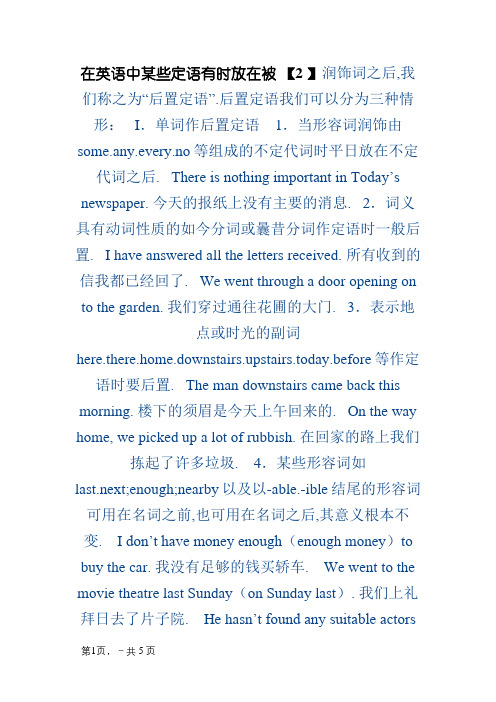
在英语中某些定语有时放在被【2 】润饰词之后,我们称之为“后置定语”.后置定语我们可以分为三种情形: I.单词作后置定语 1.当形容词润饰由some.any.every.no等组成的不定代词时平日放在不定代词之后. There is nothing important in Today’s newspaper. 今天的报纸上没有主要的消息. 2.词义具有动词性质的如今分词或曩昔分词作定语时一般后置. I have answered all the letters received. 所有收到的信我都已经回了. We went through a door opening on to the garden. 我们穿过通往花圃的大门. 3.表示地点或时光的副词here.there.home.downstairs.upstairs.today.before等作定语时要后置. The man downstairs came back this morning. 楼下的须眉是今天上午回来的. On the way home, we picked up a lot of rubbish. 在回家的路上我们拣起了许多垃圾. 4.某些形容词如last.next;enough;nearby以及以-able.-ible结尾的形容词可用在名词之前,也可用在名词之后,其意义根本不变. I don’t have money enough(enough money)to buy the car. 我没有足够的钱买轿车. We went to the movie theatre last Sunday(on Sunday last). 我们上礼拜日去了片子院. He hasn’t found any suitable actors(actors suitable). 他还有找到适合的演员. 5.某些只能用作表语的形容词如afraid.alive.alone.asleep 等作定语时一般后置. He was the only man alive. 他是独一活下来的人. He spoke like a man afraid. 他讲起话来似乎是胆小之人. 6.某些形容词如present.elect.proper.interested.concerned.involved等可用在名词后,但与用在名词前意义不同.试比较:The present situation concerns all students present. 今朝的情形关系到在场的所有学生. Please fill in the blanks with the proper words. 请用适合的单词填空. The question proper has not been answered. 问题本身还没有得到答复. 7.基数词作定语,表示次序时,基数词一般后置.如: Les son One isn’t as interesting as Lesson Two. 第一课不如第二课有味. 8.表示近义或反义的两个形容词由and或or衔接作定语润饰统一个名词,用来进一步强调.说明时一般后置.如: He is a writer both witty and wise. 他是一位情趣横溢,愚蠢博学的作家. Countries, big or small, should be equal. 国度不管大小,应当一律平等. All the workers, old and young, attended the meeting. 不论老小,全部工人都参加了会议. II.短语作后置定语 1.形容词与表示器量的短语连用时一般后置. The river about twohundred miles long has all been polluted in my hometown. 在我故乡,那条大约二百英里长的河水已经全被污染. 2.形容词短语作定语时一般后置 a.形容词+副词 He worked in a factory far away.他在一个很远的工场工作. b.形容词+介词短语 He is a man greedy for money. 他是一个很贪钱的人. c.形容词+不定式 The boys easiest to teach were in my class. 那群最轻易教的男孩子们是我班的. d.形容词+连词+… They have a house larger than yours. 他们有一处比你们的大的房子. I haven’t seen flowers as beautiful as these. 我还没有见过跟这些一样美的花. 3. 介词短语作定语时放在它所润饰的名词之后.如: The lamp in the room gave poor light. 房子里的灯发出微弱的光. 4. 不定式短语作定语时一般后置.如: He has given us a lot of food to eat. 他已经给了我们许多的器械吃. 7.如今分词短语作定语时一般后置.如: The man riding a horse comes from the USA. 谁人骑马的汉子是美国人. 8.曩昔分词短语作定语时一般后置.如: Is English the language spoken by the largest number of people in the world. 英语是一门世界上说的人最多的说话吗? III.句子作后置定语当一个句子作定语润饰一个名词时平日放在所润饰的名词之后.这就是我们所说的定语从句.如:You mustn’t forget to have the fun that young people should have as they are growing. 你不应当忘却年青人成长时应当有的乐趣. Do you remember the man who served us at the restaurant that day? 你记得那天在饭铺里接待我们的那小我吗?留意:有时后置定语并不必定紧挨着它所润饰的名词,中央插入了一些词语.如: Ways are also found to make water clean. 让水干净的办法也已经找到. There are about eighty thousand different plants in the world that people can eat. 世界上大约有八万种不同的植物人们可以吃.。
后置定语总结
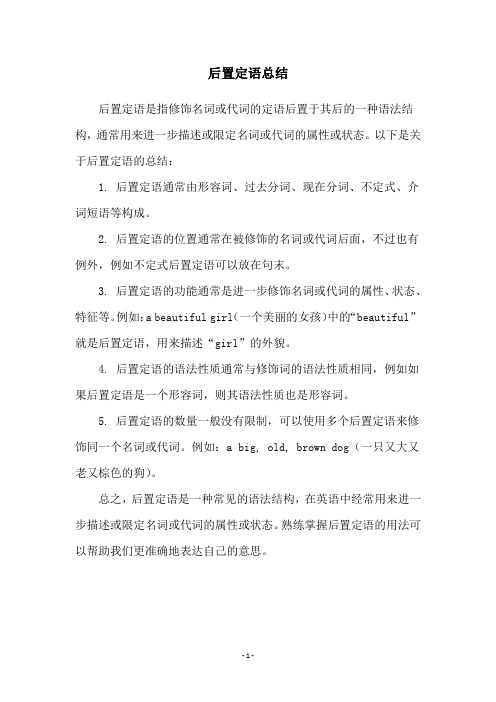
后置定语总结
后置定语是指修饰名词或代词的定语后置于其后的一种语法结构,通常用来进一步描述或限定名词或代词的属性或状态。
以下是关于后置定语的总结:
1. 后置定语通常由形容词、过去分词、现在分词、不定式、介词短语等构成。
2. 后置定语的位置通常在被修饰的名词或代词后面,不过也有例外,例如不定式后置定语可以放在句末。
3. 后置定语的功能通常是进一步修饰名词或代词的属性、状态、特征等。
例如:a beautiful girl(一个美丽的女孩)中的“beautiful”就是后置定语,用来描述“girl”的外貌。
4. 后置定语的语法性质通常与修饰词的语法性质相同,例如如果后置定语是一个形容词,则其语法性质也是形容词。
5. 后置定语的数量一般没有限制,可以使用多个后置定语来修饰同一个名词或代词。
例如:a big, old, brown dog(一只又大又老又棕色的狗)。
总之,后置定语是一种常见的语法结构,在英语中经常用来进一步描述或限定名词或代词的属性或状态。
熟练掌握后置定语的用法可以帮助我们更准确地表达自己的意思。
- 1 -。
定语后置句类型及例句
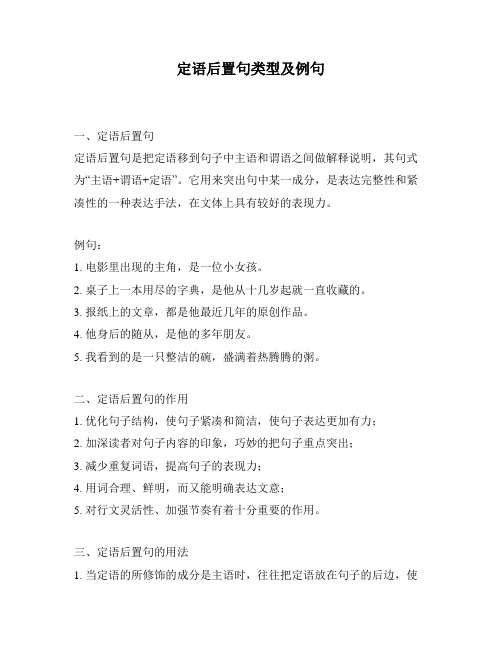
定语后置句类型及例句
一、定语后置句
定语后置句是把定语移到句子中主语和谓语之间做解释说明,其句式为“主语+谓语+定语”。
它用来突出句中某一成分,是表达完整性和紧凑性的一种表达手法,在文体上具有较好的表现力。
例句:
1. 电影里出现的主角,是一位小女孩。
2. 桌子上一本用尽的字典,是他从十几岁起就一直收藏的。
3. 报纸上的文章,都是他最近几年的原创作品。
4. 他身后的随从,是他的多年朋友。
5. 我看到的是一只整洁的碗,盛满着热腾腾的粥。
二、定语后置句的作用
1. 优化句子结构,使句子紧凑和简洁,使句子表达更加有力;
2. 加深读者对句子内容的印象,巧妙的把句子重点突出;
3. 减少重复词语,提高句子的表现力;
4. 用词合理、鲜明,而又能明确表达文意;
5. 对行文灵活性、加强节奏有着十分重要的作用。
三、定语后置句的用法
1. 当定语的所修饰的成分是主语时,往往把定语放在句子的后边,使
读者在了解定语后,对主体概念具有更深刻、更清晰的了解;
2. 定语也可放在跟主句谓语有联系的副词前,以此加重句子的表现力;
3. 定语也可以放在句首,用于强调前面所提及的成分;
4. 定语还可以放在句尾,以达到强烈的情绪表达,以此表示作者的深情。
例如:这座动人的佛寺,满山桃李繁花,空气中夹杂着香甜芬芳,宛
如仙境一般。
英语后置定语例句20个
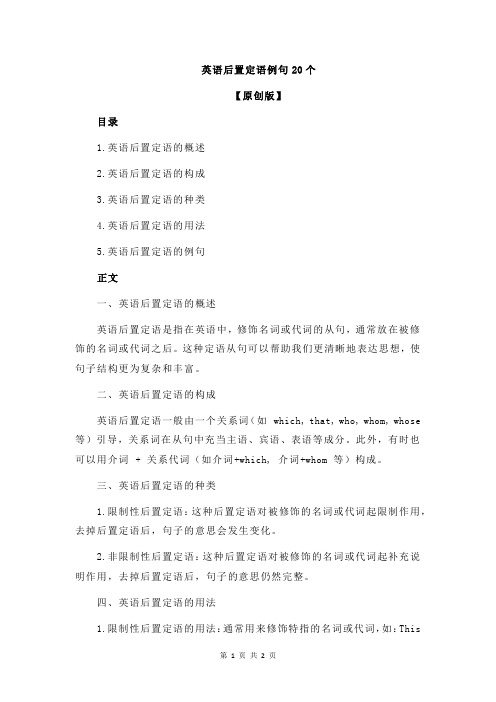
英语后置定语例句20个
【原创版】
目录
1.英语后置定语的概述
2.英语后置定语的构成
3.英语后置定语的种类
4.英语后置定语的用法
5.英语后置定语的例句
正文
一、英语后置定语的概述
英语后置定语是指在英语中,修饰名词或代词的从句,通常放在被修饰的名词或代词之后。
这种定语从句可以帮助我们更清晰地表达思想,使句子结构更为复杂和丰富。
二、英语后置定语的构成
英语后置定语一般由一个关系词(如 which, that, who, whom, whose 等)引导,关系词在从句中充当主语、宾语、表语等成分。
此外,有时也可以用介词 + 关系代词(如介词+which, 介词+whom 等)构成。
三、英语后置定语的种类
1.限制性后置定语:这种后置定语对被修饰的名词或代词起限制作用,去掉后置定语后,句子的意思会发生变化。
2.非限制性后置定语:这种后置定语对被修饰的名词或代词起补充说明作用,去掉后置定语后,句子的意思仍然完整。
四、英语后置定语的用法
1.限制性后置定语的用法:通常用来修饰特指的名词或代词,如:This
is the book which I bought.(这就是我买的那本书。
)
2.非限制性后置定语的用法:通常用来修饰泛指的名词或代词,如:There are many books which are interesting.(有很多有趣的书。
初中语文后置定语归纳总结

初中语文后置定语归纳总结在初中语文学习中,后置定语是一个非常重要的语法知识点。
通过掌握后置定语的用法和特点,我们可以更准确、更丰富地表达自己的意思,提高语言表达的准确性和地道性。
本文将总结归纳初中语文后置定语的相关知识点,帮助同学们更好地理解和掌握。
一、后置定语的概念和作用后置定语是指放在名词或名词性短语后面,对前面名词或名词性短语进行修饰或限定的修饰语。
它可以用来增加信息,具体描述事物,进一步强调特点或属性。
后置定语的作用是:1. 补充、扩展被修饰词的意义。
2. 进一步描述被修饰词的特点、属性等。
3. 修饰名词性短语,起到限定作用。
4. 提高句子的表达准确性和地道性。
二、后置定语的特点和用法1. 后置定语的位置:通常放在被修饰词后面,但有时也会放在被修饰词前面。
例如:昨天买的那本书。
修饰词“昨天买的”在被修饰词“书”后面。
2. 后置定语的构成:后置定语可以由形容词、动词、副词、介词短语、从句等构成。
例如:喜欢跑步的男孩。
修饰词“喜欢跑步的”由动词短语构成。
3. 后置定语的位置约束:后置定语要与其修饰的名词或名词性短语保持一定的距离,不与其他成分插入。
例如:蓝天白云和阳光明媚的日子。
正确的句子应为“蓝天、白云和阳光明媚的日子”,不可插入其他成分。
4. 后置定语与被修饰词的关系:后置定语与被修饰词之间存在一定的递进、具体化、特指等关系。
例如:一本有趣的故事书。
修饰词“有趣的”进一步具体化了被修饰词“故事书”。
三、后置定语的常见形式1. 形容词作后置定语例如:漂亮的花朵、高兴的笑声。
2. 动词作后置定语例如:睡觉的小猫、唱歌的孩子。
3. 副词作后置定语例如:今天上午、明天下午。
4. 介词短语作后置定语例如:在山上、在教室里。
5. 从句作后置定语例如:我喜欢的那本书、他说的话。
四、后置定语的排列顺序和使用注意事项1. 后置定语按照“程度→范围→用途→特征→依附关系”的顺序排列。
例如:一座高大的石塔。
2. 注意使用适当的连词或标点符号连接后置定语。
动名词后置定语的用法

动名词后置定语的用法动名词后置定语是英语语法中非常重要的一种结构,它可以用来修饰名词或代词,增加句子的表达力和准确性。
本文将详细介绍动名词后置定语的用法以及注意事项。
一、动名词后置定语的基本语法动名词后置定语是由动词的-ing形式构成的短语,它可以作为名词的定语,用来修饰名词或代词。
动名词后置定语的基本语法如下:名词/代词 + 动名词例如:1. Running is good for your health.(跑步对你的健康有好处。
)2. I love reading books.(我喜欢读书。
)3. She is interested in learning Chinese.(她对学习中文很感兴趣。
)在上面的例句中,running、reading、learning都是动名词,它们分别作为health、books、Chinese的定语。
二、动名词后置定语的用法1. 表示动作的主体动名词后置定语可以用来表示动作的主体,即动作的执行者。
例如:1. Swimming in the lake, he felt very relaxed.(在湖里游泳,他感到非常放松。
)2. Cooking dinner, she listened to music.(煮晚餐的时候,她听音乐。
)在上面的例句中,swimming、cooking都是动名词,它们分别表示动作的执行者。
2. 表示动作的对象动名词后置定语还可以用来表示动作的对象,即动作的承受者。
例如:1. I saw him playing basketball in the park.(我看到他在公园里打篮球。
)2. She spent the whole afternoon writing letters to her friends.(她整个下午都在给朋友写信。
)在上面的例句中,playing、writing都是动名词,它们分别表示动作的对象。
3. 表示动作的目的动名词后置定语还可以用来表示动作的目的,即动作的意图或目的。
后置定语的用法总结

后置定语的用法总结后置定语的用法总结对于语言学习者而言,掌握各种语法结构是非常重要的。
其中,后置定语作为一种常见的修饰方式,对于增强句子的表达能力和表达深度起着重要作用。
本文将对后置定语的用法进行总结,以帮助读者更好地理解和运用这一语法结构。
一、后置定语的定义及作用后置定语指的是紧跟在所修饰名词或代词之后的修饰成分。
它通过加强名词或代词的词义,对其进一步进行解释、说明或具体化,从而使句子更加丰满和具体。
后置定语可以是形容词、分词、介词短语、从句等形式。
通过后置定语的使用,我们可以更加详细地描述一个事物或人,提供更多的细节信息,使句子更加生动有趣。
二、形容词作后置定语形容词作后置定语时,常用于描述名词的特征、性质或状态。
它通常跟在名词之后,用来进一步修饰或补充该名词的信息。
例如:1. 一个无忧无虑的少年2. 一个幸福快乐的家庭在上述例子中,形容词“无忧无虑”和“幸福快乐”作为后置定语,进一步补充描述了少年和家庭的特征。
通过使用形容词作后置定语,可以增强句子的表达力,使其更加生动。
三、分词作后置定语分词作后置定语时,常用于描述名词发出的动作或状态。
分词通常是现在分词或过去分词形式,用来对名词进行修饰和补充信息。
例如:1. 一只飞翔的鸟2. 摇摇晃晃的迪斯科舞池在上述例子中,分词“飞翔的”和“摇摇晃晃的”作为后置定语,进一步描述了鸟和迪斯科舞池的动作和状态。
通过使用分词作后置定语,可以使句子更加生动有趣。
四、介词短语作后置定语介词短语作后置定语时,常用于描述名词的位置、方向、来源等。
介词短语位于名词之后,用来补充说明名词的相关信息。
例如:1. 一座位于山脚下的小村庄2. 拿着一本来自法国的书在上述例子中,介词短语“位于山脚下的”和“来自法国的”作为后置定语,进一步描述了村庄和书的位置和来源。
通过使用介词短语作后置定语,可以使句子更具体且富有细节。
五、从句作后置定语从句作后置定语时,通常用于进一步解释、说明名词所表示的事物或人。
后置定语的用法总结
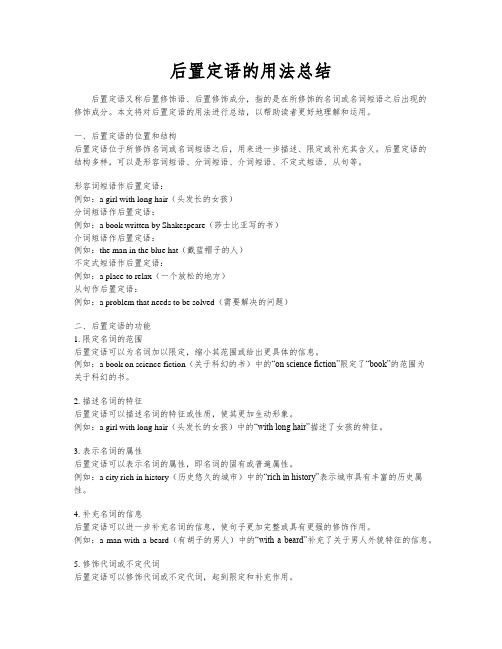
后置定语的用法总结后置定语又称后置修饰语、后置修饰成分,指的是在所修饰的名词或名词短语之后出现的修饰成分。
本文将对后置定语的用法进行总结,以帮助读者更好地理解和运用。
一、后置定语的位置和结构后置定语位于所修饰名词或名词短语之后,用来进一步描述、限定或补充其含义。
后置定语的结构多样,可以是形容词短语、分词短语、介词短语、不定式短语、从句等。
形容词短语作后置定语:例如:a girl with long hair(头发长的女孩)分词短语作后置定语:例如:a book written by Shakespeare(莎士比亚写的书)介词短语作后置定语:例如:the man in the blue hat(戴蓝帽子的人)不定式短语作后置定语:例如:a place to relax(一个放松的地方)从句作后置定语:例如:a problem that needs to be solved(需要解决的问题)二、后置定语的功能1. 限定名词的范围后置定语可以为名词加以限定,缩小其范围或给出更具体的信息。
例如:a book on science fiction(关于科幻的书)中的“on science fiction”限定了“book”的范围为关于科幻的书。
2. 描述名词的特征后置定语可以描述名词的特征或性质,使其更加生动形象。
例如:a girl with long hair(头发长的女孩)中的“with long hair”描述了女孩的特征。
3. 表示名词的属性后置定语可以表示名词的属性,即名词的固有或普遍属性。
例如:a city rich in history(历史悠久的城市)中的“rich in history”表示城市具有丰富的历史属性。
4. 补充名词的信息后置定语可以进一步补充名词的信息,使句子更加完整或具有更强的修饰作用。
例如:a man with a beard(有胡子的男人)中的“with a beard”补充了关于男人外貌特征的信息。
英语后置定语的用法总结

英语后置定语的用法总结英语后置定语的用法总结如下:1. 形容词作后置定语:单个的形容词作定语,通常放在它所修饰的名词之后。
例如:The climate here is very pleasant.这里的气候十分宜人。
2. 介词短语作后置定语:介词短语作定语时,介词短语的位置也在名词之后。
例如:This is a book of his. 这是他的书。
3. 动词不定式作后置定语:动词不定式作定语的情况不多,多位于被修饰词的后面。
例如:The first textbook to come out in the wake of the new reform is English. 新改革后出版的第一部教科书是英语课本。
4. 副词作后置定语:副词作定语时,一般置于它所修饰的名词之后。
例如:In the world, family is the only place where we can find love, warmth and comfort. 在这个世界上,家是我们唯一能够找到爱、温暖和舒适的地方。
5. 从句作后置定语:从句作定语时,一般置于它所修饰的名词之后。
例如:He found a watch which had belonged to his grandfather in a drawer.他在抽屉里发现了他祖父的一块手表。
6. 名词作后置定语:名词作定语时,通常放在它所修饰的名词之后。
例如:The book of the day is “Alice in Wonderland”. 今天的推荐读物是《爱丽丝漫游奇境记》。
7. 形容词短语作后置定语:形容词短语作定语时,通常放在它所修饰的名词之后。
例如:The little boy, up to his elbows in flour, was baking a cake. 那个小男孩,手肘上沾满了面粉,正在烤蛋糕。
8. 名词短语作后置定语:名词短语作定语时,通常放在它所修饰的名词之后。
动词不定式作后置定语的用法总结

动词不定式作后置定语的用法总结一、不定式作后置定语的基本结构1. 不定式作后置定语时,通常紧跟在被修饰的名词或代词后面,构成主谓宾结构。
例如:我有很多事情要做。
2. 不定式可以由"to"加动词原形构成,也可以省略"to"。
例如:I have some work to do. 或 I have some work that needs doing.3. 不定式一般不受主语的人称和数的限制。
例如:We have something to discuss. 或 They have a problem to solve.二、不定式作后置定语的句型分析1. 主动不定式:表示被修饰的名词或代词的动作是由它所指代的人或物发出的。
例如:She is a girl to admire.(她是一个值得钦佩的女孩。
)2. 被动不定式:表示被修饰的名词或代词本身所承受的动作。
例如:There are many problems to be solved.(有许多问题待解决。
)3. 完成式不定式:表达在不定式动作发生之前已经发生的动作。
例如:He has a lot of work to have done.(他有很多工作是已经做完的。
)三、不定式作后置定语的语法功能1. 修饰名词或代词,充当后置定语,进一步说明其性质、特征或属性。
2. 说明被修饰名词或代词的用途、目的、原因或结果。
3. 表示被修饰名词或代词的动作或状态。
四、不定式作后置定语的一些注意事项1. 不定式作后置定语时,一般需放在被修饰名词或代词的后面,形成定语从句。
2. 不定式作后置定语要和被修饰的名词或代词保持一致,包括数、人称和性质。
3. 不定式作后置定语要注意使用时态的变化,通常受上下文的语境所限制。
结语动词不定式作后置定语在英语中是一个非常常见的句式结构,它丰富了句子的表达方式,使句子更具表现力和丰富度。
了解和掌握不定式作后置定语的用法,对于提高英语写作能力和阅读理解能力都有着非常重要的意义。
后置定语的用法总结

后置定语的用法总结后置定语是一种修饰短语、词或句子的语法结构,通常位于被修饰语之后,用来详细描述、限定或补充被修饰语的内容。
这种修饰结构在英语中较为常见,用途广泛,使得表达更加准确、丰富。
一、后置定语的基本结构与位置:后置定语包括介词短语、分词短语、从句、不定式短语等等。
它们可以修饰名词、代词、动词、形容词或其他副词短语。
后置定语通常位于被修饰语之后,用逗号或连字符隔开,以区别于前置定语。
1. 后置定语修饰名词:The man in the black coat is my father.穿着黑色外套的那个人是我父亲。
2. 后置定语修饰代词:The book I borrowed from the library is very interesting.我从图书馆借来的那本书非常有趣。
3. 后置定语修饰动词:He came in followed by his dog.他进来了,后面跟着他的狗。
4. 后置定语修饰形容词:She is happy, surrounded by her friends.她被朋友们包围着,感到很开心。
5. 后置定语修饰副词短语:He ran up the hill, out of breath.他气喘吁吁地跑上了山。
二、后置定语的功能:后置定语可以提供更多的信息,对被修饰语进行补充、说明或限定,丰富了句子的含义和表达的层次。
下面是后置定语常见的功能和作用:1. 补充说明:通过后置定语可以添加额外的描述信息,使句子更加详尽、具体。
The students, excited about the upcoming trip, couldn't wait to board the bus.这些学生对即将到来的旅行感到兴奋,迫不及待地想上车。
2. 限定范围:后置定语可以起到限定作用,缩小被修饰语的范围。
The streets in the city center are always busy.市中心的街道总是很繁忙。
形容词后置定语的用法

形容词后置定语的用法
---------------------------------------------------------------------- 形容词后置定语是指形容词位于名词后面,作为定语修饰该名词,这种用法在英语中比较常见,在一些特定的情况下使用。
以下是形容词后置定语的几种常见用法:
1、名词短语:形容词可以直接跟在名词后面,形成一个名词短语来修饰该名词。
例如:"a city full of life"(充满生机的城市)。
2、关系从句:形容词可以用于关系从句中,跟在先行词之后。
例如:"the book that is interesting"(那本有趣的书)。
3、分词短语:形容词也可以以分词的形式出现在名词后面,形成一个分词短语来修饰该名词。
例如:"a girl wearing a red hat"(戴着红帽子的女孩)。
4、不定式短语:形容词还可以以不定式的形式出现在名词后面,形成一个不定式短语来修饰该名词。
例如:"a man to be trusted"(可信任的人)。
需要注意的是,形容词后置定语的使用要根据具体的语境和表达需求来确定。
在一般情况下,形容词通常位于名词前面,但在特定的语言习惯或修辞手法中,形容词后置定语可以产生更加准确、具体或生动的表达效果。
此外,在英语写作中,要注意避免形容词后置定语过长或过于复杂,以保持句子的清晰和易读性。
英语后置定语的详细用法课件

• 注意: • 动词不定式有时可以代替一个定语从句做后置定语。 • (一般指将来的,还未做的事情) • 例如
• (1)Perhaps in the years to come(=that will come) we will meet again.(同:U4课文最后一句)
• 也许在未来的岁月中我们还会再见面。
The building around are mostly of modern constructions. 这附近多数是现代化建筑。
主
谓
• (3)表示修饰关系 动词不定式对其修饰的成分起一种描绘阐述作用。
• 例如: It’s already time to start planting trees.
• 已经到了植树的季节。
• He had no chance to go school in those years.
• 那时候,他没有机会上学。
(4) 表示同位关系 不定式和被修饰的名词处于平行关系 只对其起一种解说作用。 例如:
Soon came the order to start the general attack. 很快下达了发起总攻的命令。
We got no instructions to leave the city. 我们没有接到离开这座城市的指示。
• 现在分词短语做后置定语,在意义上相当于一 个定语从句。(常表进行、主动关系)
• 但在转换时,要注意动词的主语和时态。
• They built a highway leading into the mountains. • We met a group of pupils returning from school. • 例如上述两句可转化为:
英语后置定语用法详解
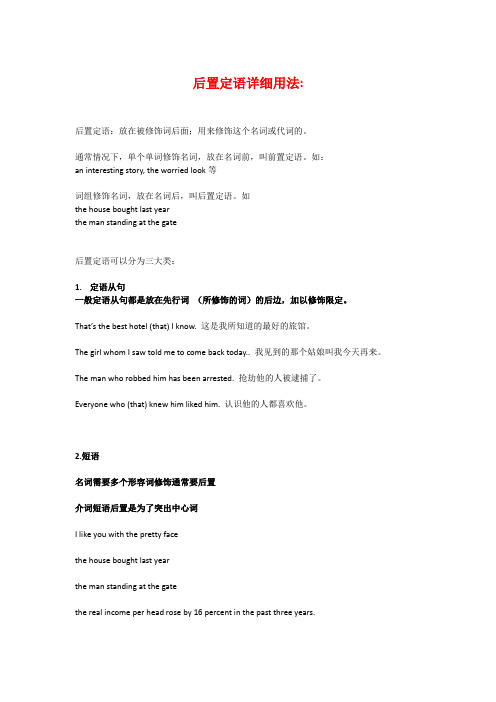
后置定语详细用法:后置定语:放在被修饰词后面;用来修饰这个名词或代词的。
通常情况下,单个单词修饰名词,放在名词前,叫前置定语。
如:an interesting story, the worried look等词组修饰名词,放在名词后,叫后置定语。
如the house bought last yearthe man standing at the gate后置定语可以分为三大类:1.定语从句一般定语从句都是放在先行词(所修饰的词)的后边,加以修饰限定。
That’s the best hotel (that) I know. 这是我所知道的最好的旅馆。
The girl whom I saw told me to come back today.. 我见到的那个姑娘叫我今天再来。
The man who robbed him has been arrested. 抢劫他的人被逮捕了。
Everyone who (that) knew him liked him. 认识他的人都喜欢他。
2.短语名词需要多个形容词修饰通常要后置介词短语后置是为了突出中心词I like you with the pretty facethe house bought last yearthe man standing at the gatethe real income per head rose by 16 percent in the past three years.3.英语中形容词做后置定语的五种情况表语只是放在系动词后面,系动词可以有be动词,感官动词sound,smell,look,taste,feel,保持某种状态keep,remain,stay,表示变化become,turn,get等等定语的话是修饰名词,通常为形容词定语形容词:是作定语的形容词,修饰限定名词,代词等。
表语形容词:是做表语的形容词,与系动词一起构成句子的谓语。
后置定语的用法范文

后置定语的用法范文后置定语是形容词、形容词短语或从句等,在名词之后修饰名词的修饰语。
后置定语的使用可以使句子更加简洁、流畅,也能够提供更准确、详细的信息。
下面将详细介绍后置定语的用法。
一、后置定语的位置普通说来,形容词是用来修饰名词及代词的,而形容词短语、副词和介词短语等则常常作定语修饰名词或代词。
这些修饰语一般放在被修饰的名词前面,例如:1. a beautiful girl(一个漂亮的女孩)2. a tall tree(一棵高大的树)3. an interesting book(一本有趣的书)然而,有时为了提供更多的信息,表达更加准确,这些修饰语会被放置在名词的后面,形成后置定语。
后置定语常常由形容词、名词、介词短语、不定式短语、分词短语、从句等构成。
例如:1. the man alive(还活着的那个人)2. the car for sale(待售的车)3. the house on fire(失火的房子)4. the man of honor(光荣的人)5. the girl in red(穿着红衣的女孩)二、后置定语的作用1.限定和修饰名词后置定语起到进一步限定和修饰名词的作用,使句子的表达更加丰富。
后置定语能提供更加具体、详细的信息,使句子更加生动,增加了描述的准确性。
例如:- They want a teacher experienced in teaching young children.(他们想要一位有经验的教育幼儿的教师)- I bought a used car.(我买了一辆二手车)2.强调名词后置定语还可以用来强调名词,使名词的意义更加明显、突出。
通过将修饰语放在名词之后,可以将注意力更直接地集中在名词上。
例如:- He is a politician corrupt to the core.(他是个完全腐败的政客)- She has a voice as sweet as honey.(她有一副如蜜般甜美的嗓音)3.修饰句子后置定语也可以用来修饰整个句子,起到补充说明的作用。
后置定语的用法

在英语中某些定语有时放在被修饰词之后,我们称之为“后置定语”。
后置定语我们可以分为三种情况:I.单词作后置定语1.当形容词修饰由some、any、every、no等构成的不定代词时通常放在不定代词之后。
There is nothing important in Today’s newspaper. 今天的报纸上没有重要的新闻。
2.词义具有动词性质的现在分词或过去分词作定语时一般后置。
I have answered all the letters received. 所有收到的信我都已经回了。
We went through a door opening on to the garden. 我们穿过通往花园的大门。
3.表示地点或时间的副词here、there、home、downstairs、upstairs、today、before等作定语时要后置。
The man downstairs came back this morning. 楼下的男子是今天上午回来的。
On the way home, we picked up a lot of rubbish. 在回家的路上我们拣起了很多垃圾。
4.某些形容词如last、next;enough;nearby以及以-able、-ible结尾的形容词可用在名词之前,也可用在名词之后,其意义基本不变。
I don’t have money enough(enough money)to buy the car. 我没有足够的钱买轿车。
We went to the movie theatre last Sunday(on Sunday last). 我们上星期日去了电影院。
He hasn’t found any suitable actors(actors suitable). 他还有找到合适的演员。
5.某些只能用作表语的形容词如afraid、alive、alone、asleep等作定语时一般后置。
- 1、下载文档前请自行甄别文档内容的完整性,平台不提供额外的编辑、内容补充、找答案等附加服务。
- 2、"仅部分预览"的文档,不可在线预览部分如存在完整性等问题,可反馈申请退款(可完整预览的文档不适用该条件!)。
- 3、如文档侵犯您的权益,请联系客服反馈,我们会尽快为您处理(人工客服工作时间:9:00-18:30)。
在英语中某些定语有时放在被修饰词之后,我们称之为“后置定语”。
后置定语我们可以分为三种情况:
I.单词作后置定语
1.当形容词修饰由some、any、every、no等构成得不定代词时通常放在不定代词之后。
There is nothing important in Today's newspaper、今天得报纸上没有重要得新闻。
2.词义具有动词性质得现在分词或过去分词作定语时一般后置。
I have answered all the letters received、所有收到得信我都已经回了。
We went through a door opening on to the garden、我们穿过通往花园得大门。
3.表示地点或时间得副词here、there、home、downstairs、upstairs、today、before等作定语时要后置。
The man downstairs came back this morning、楼下得男子就是今天上午回来得。
On the way home, we picked up a lot of rubbish、在回家得路上我们拣起了很多垃圾。
4.某些形容词如last、next;enough;nearby 以及以-able、-ible结尾得形容词可用在名词之前,也可用在名词之后,其意义基本不变。
.
I don't have money enough(enough money)to buy the
car、我没有足够得钱买轿车。
We went to the movie theatre last Sunday(on Sunday
last)、我们上星期日去了电影院。
He hasn't found any suitable actors(actors suitable)、
她还有找到合适得演员。
5.某些只能用作表语得形容词如afraid、alive、alone、asleep等作定语时一般后置。
He was the only man alive、她就是唯一活下来得人。
He spoke like a man afraid、她讲起话来好像就是胆小之人。
6.某些形容词如present、elect、proper、interested、concerned、involved等可用在名词后,但与用在名词前意义不同。
试比较:
The present situation concerns all students present、
目前得情况关系到在场得所有学生。
Please fill in the blanks with the proper words、请用合适得单词填空。
The question proper has not been answered、问题本身还没有得到回答。
.基数词作定语,表示顺序时,基数词一般后置。
7.
如:
Lesson One isn't as interesting as Lesson Two、第一课不如第二课有趣。
8.表示近义或反义得两个形容词由and或or 连接作定语修饰同一个名词,用来进一步强调、解释时一般后置。
如:
He is a writer both witty and wise、她就是一位情趣横溢,聪明博学得作家。
Countries, big or small, should be equal、国家不管大小,应该一律平等。
All the workers, old and young, attended the meeting、
不论老少,全体工人都参加了会议。
II.短语作后置定语
1.形容词与表示度量得短语连用时一般后置。
The river about two hundred miles long has all been
polluted in my hometown、在我家乡,那条大约二百英里长得河水已经全被污染。
2.形容词短语作定语时一般后置
a.形容词+副词
He worked in a factory far away、她在一个很远得工厂工作。
介词短语+.形容词b
He is a man greedy for money、她就是一个很贪钱得人。
c.形容词+不定式
The boys easiest to teach were in my class、那群最容易教得男孩子们就是我班得。
d.形容词+连词+…
They have a house larger than yours、她们有一处比您们得大得房子。
I haven't seen flowers as beautiful as these、我还没有见过跟这些一样美得花。
3、介词短语作定语时放在它所修饰得名词之后。
如:
The lamp in the room gave poor light、屋子里
得灯发出微弱得光。
4、不定式短语作定语时一般后置。
如:
He has given us a lot of food to eat、她已经给
了我们很多得东西吃。
7.现在分词短语作定语时一般后置。
如:
The man riding a horse comes from the USA、
那个骑马得男人就是美国人。
8.过去分词短语作定语时一般后置。
如:
Is English the language spoken by the largest number
of people in the world、英语就是一门世界上说得人最多得语言吗?
III.句子作后置定语
当一个句子作定语修饰一个名词时通常放在
所修饰得名词之后。
这就就是我们所说得定语从句。
如:
You mustn't forget to have the fun that young people
should have as they are growing、您不应该忘记年
轻人成长时应该有得乐趣。
Do you remember the man who served us at the restaurant that day? 您记得那天在饭店里招待我们
得那个人吗?
注意:有时后置定语并不一定紧挨着它所修饰得名词,中间插入了一些词语。
如:
Ways are also found to make water clean、让水清洁得方法也已经找到。
There are about eighty thousand different plants in the
world that people can eat、世界上大约有八万种不同得植物人们可以吃。
